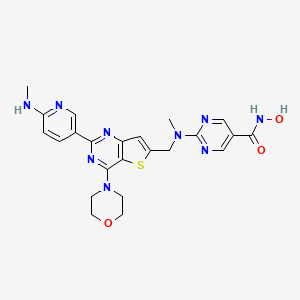Ferroptosis-centered Drug Response Information
General Information of the Drug (ID: ferrodrug0366)
| Name |
BEBT-908
|
||||
|---|---|---|---|---|---|
| Synonyms |
BEBT-908; 1235449-52-1; CUDC-908; DQ7TD3X4ZJ; N-hydroxy-2-[methyl-[[2-[6-(methylamino)pyridin-3-yl]-4-morpholin-4-ylthieno[3,2-d]pyrimidin-6-yl]methyl]amino]pyrimidine-5-carboxamide; BEBT-908CUDC-908; 5-Pyrimidinecarboxamide, N-hydroxy-2-(methyl((2-(6-(methylamino)-3-pyridinyl)-4-(4-morpholinyl)thieno(3,2-d)pyrimidin-6-yl)methyl)amino)-; N-Hydroxy-2-(methyl((2-(6-(methylamino)-3-pyridinyl)-4-(4-morpholinyl)thieno(3,2-d)pyrimidin-6-yl)methyl)amino)-5-pyrimidinecarboxamide; PI3Ka inhibitor 1; UNII-DQ7TD3X4ZJ; BEBT908 FREE BASE; BEBT-908 FREE BASE; CUDC 908; SCHEMBL1284514; BCP17145; EX-A1176; CS-5445; AC-36829; HY-19763; MS-29429; F85359; A906906; PI3KAfAE'A centa' notA inverted exclamation markAfasA'A; AfAE'Adaggeratrade mark? inhibitor 1
Click to Show/Hide
|
||||
| Structure |
 |
||||
| Formula |
C23H25N9O3S
|
||||
| IUPAC Name |
N-hydroxy-2-[methyl-[[2-[6-(methylamino)pyridin-3-yl]-4-morpholin-4-ylthieno[3,2-d]pyrimidin-6-yl]methyl]amino]pyrimidine-5-carboxamide
|
||||
| Canonical SMILES |
CNC1=NC=C(C=C1)C2=NC3=C(C(=N2)N4CCOCC4)SC(=C3)CN(C)C5=NC=C(C=N5)C(=O)NO
|
||||
| InChI |
InChI=1S/C23H25N9O3S/c1-24-18-4-3-14(10-25-18)20-28-17-9-16(36-19(17)21(29-20)32-5-7-35-8-6-32)13-31(2)23-26-11-15(12-27-23)22(33)30-34/h3-4,9-12,34H,5-8,13H2,1-2H3,(H,24,25)(H,30,33)
|
||||
| InChIKey |
TWJZFXHSPBBPNI-UHFFFAOYSA-N
|
||||
| PubChem CID | |||||
Full List of Ferroptosis Target Related to This Drug
Unspecific Target
| In total 2 item(s) under this Target | |||||
| Experiment 1 Reporting the Ferroptosis-centered Drug Act on This Target | [1] | ||||
| Responsed Disease | Colorectal cancer | ICD-11: 2B91 | |||
| Responsed Regulator | Histone deacetylase 1 (HDAC1) | Suppressor | |||
| Pathway Response | Fatty acid metabolism | hsa01212 | |||
| Ferroptosis | hsa04216 | ||||
| PI3K-Akt signaling pathway | hsa04151 | ||||
| Cell Process | Cell ferroptosis | ||||
| Cell proliferation | |||||
| In Vitro Model | MC-38 cells | Colon adenocarcinoma | Homo sapiens | CVCL_B288 | |
| In Vivo Model |
About 2 x 105 MC38 tumor cells were inoculated subcutaneously into C57BL/6 mice. A total of 100 mg/kg BEBT-908 was intravenously injected every other day for four times initiating from day 4 after tumor cell inoculation. Tumors were harvested on day 12 after inoculation, weighted, mechanically minced and incubated with 50 ug/mL DNase I (Sigma) and 2 mg/mL collagenase P (Sigma) for 20 minutes at 37.
Click to Show/Hide
|
||||
| Response regulation | Treatment with BEBT-908 promoted ferroptotic cell death of cancer cells by hyperacetylating p53 and facilitating the expression of ferroptotic signaling. The dual PI3K/HDAC inhibitor BEBT-908 elicits potent antitumor responses, effectively inducing immunogenic ferroptosis of colorectal cancer cells and potentiating cancer immunotherapy. | ||||
| Experiment 2 Reporting the Ferroptosis-centered Drug Act on This Target | [1] | ||||
| Responsed Disease | Colorectal cancer | ICD-11: 2B91 | |||
| Responsed Regulator | Cellular tumor antigen p53 (TP53) | Driver | |||
| Pathway Response | Fatty acid metabolism | hsa01212 | |||
| Ferroptosis | hsa04216 | ||||
| PI3K-Akt signaling pathway | hsa04151 | ||||
| Cell Process | Cell ferroptosis | ||||
| Cell proliferation | |||||
| In Vitro Model | MC-38 cells | Colon adenocarcinoma | Homo sapiens | CVCL_B288 | |
| In Vivo Model |
About 2 x 105 MC38 tumor cells were inoculated subcutaneously into C57BL/6 mice. A total of 100 mg/kg BEBT-908 was intravenously injected every other day for four times initiating from day 4 after tumor cell inoculation. Tumors were harvested on day 12 after inoculation, weighted, mechanically minced and incubated with 50 ug/mL DNase I (Sigma) and 2 mg/mL collagenase P (Sigma) for 20 minutes at 37.
Click to Show/Hide
|
||||
| Response regulation | Treatment with BEBT-908 promoted ferroptotic cell death of cancer cells by hyperacetylating p53 and facilitating the expression of ferroptotic signaling. The dual PI3K/HDAC inhibitor BEBT-908 elicits potent antitumor responses, effectively inducing immunogenic ferroptosis of colorectal cancer cells and potentiating cancer immunotherapy. | ||||
